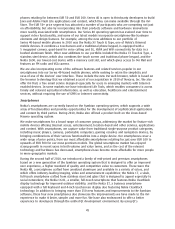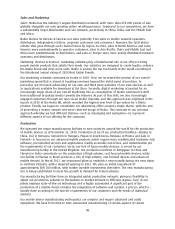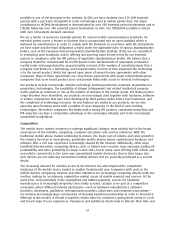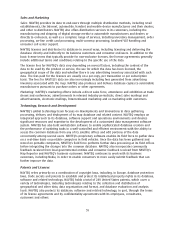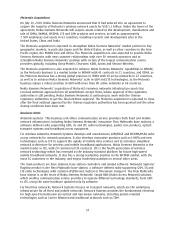Nokia 2010 Annual Report Download - page 52
Download and view the complete annual report
Please find page 52 of the 2010 Nokia annual report below. You can navigate through the pages in the report by either clicking on the pages listed below, or by using the keyword search tool below to find specific information within the annual report.portfolio is one of the strongest in the industry. In GSM, we have declared over 320 GSM essential
patents with a particular stronghold in codec technologies and in mobile packet data. Our major
contribution to WCDMA development is demonstrated by over 430 essential patent declarations and in
LTE/SAE Nokia has over 300 essential patent declarations to date. Our CDMA2000 portfolio is robust
with over 160 patents declared essential.
We are a holder of numerous essential patents for various mobile communications standards. An
essential patent covers a feature or function that is incorporated into an open standard which is
deployed by manufacturers in order to comply with the standard. In accordance with the declarations
we have made and the legal obligations created under the applicable rules of various standardization
bodies, such as the European Telecommunication Standardization Institute (ETSI), we are committed
to promoting open standards, and to offering and agreeing upon license terms for our essential
patents in compliance with the IPR policies of applicable standardization bodies. We believe that a
company should be compensated for its IPR based on the fundamentals of reasonable cumulative
royalty terms and proportionality: proportionality in terms of the number of essential patents that a
company contributes to a technology, and proportionality in terms of how important the technology
is to the overall product. Nokia has agreed upon terms of several license agreements with other
companies. Many of these agreements are crosslicense agreements with major telecommunications
companies that cover broad product areas and provide Nokia with access to relevant technologies.
Our products include increasingly complex technology involving numerous patented, standardized or
proprietary, technologies. The possibility of alleged infringement and related intellectual property
claims against us continues to rise as the number of entrants in the market grows, the Nokia product
range becomes more diversified, our products are increasingly used together with hardware, software
or service components that have been developed by third parties, Nokia enters new businesses, and
the complexity of technology increases. As new features are added to our products, we are also
agreeing upon licensing terms with a number of new companies in the field of new evolving
technologies. We believe companies like Nokia with a strong IPR position, cumulative knowhow and
IPR expertise can have a competitive advantage in the converging industry, and in the increasingly
competitive marketplace.
Competition
The mobile device market continues to undergo significant changes, most notably due to the broad
convergence of the mobility, computing, consumer electronics and services industries. With the
traditional mobile phone market continuing to mature, the major part of volume and value growth in
the industry has been in smartphones, pocketable mobile devices whose sophisticated hardware and
software offer a rich user experience increasingly shaped by the Internet. Additionally, other large
handheld Internetcentric computing devices, such as tablets and ereaders, have emerged, trading off
pocketability and some portability for larger screen sizes, but in many cases offering both cellular and
noncellular connectivity in the same way conventional mobile devices do. Due to their larger size,
such devices are not replacing conventional mobile devices, but are generally purchased as a second
device.
The increasing demand for wireless access to the Internet has also impacted the competitive
landscape of the mobile device market in another fundamental way. Companies with roots in the
mobile devices, computing, Internet and other industries are increasingly competing directly with one
another, making for an intensely competitive market across all mobile products and services. At the
same time, and particularly in the smartphone and tablets segments, success for hardware
manufacturers is increasingly shaped by their ability to build, catalyze or be part of a competitive
ecosystem, where different industry participants—such as hardware manufacturers, software
providers, developers, publishers, entertainment providers, advertisers and ecommerce specialists—
are forming increasingly large communities of mutually beneficial partnerships in order to bring their
offerings to the market. A vibrant ecosystem creates value for consumers, giving them access to a rich
and broad range of user experiences. Developers and publishers decide how to allocate their time and
51






